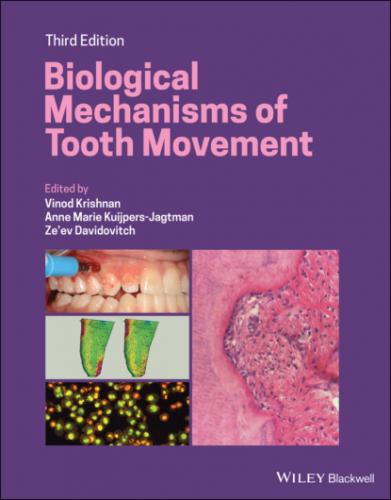Biological Mechanisms of Tooth Movement. Группа авторов
in teeth subjected to orthodontic forces, a finding confirmed by Gruber in 1931. Even before these histological observations of surface changes were reported, Ketcham (Figure 1.10) (1927, 1929) presented, radiographic evidence that root resorption may result from the application of faulty mechanics and the existence of some unknown systemic factors. Schwarz (1932) conducted extensive experiments on premolars in dogs, using known force levels for each tooth. The effects of orthodontic force magnitude on the dog’s paradental tissue responses were examined with light microscopy. Schwarz classified orthodontic forces into four degrees of biological efficiency:
Figure 1.10 Albert Ketcham (1870–1935), who presented the first radiographic evidence of root resorption. He was also instrumental in forming the American Board of Orthodontics.
(Source: Siersma, 2015. Reproduced with permission of Elsevier.)
below threshold stimulus;
most favorable – about 20 g/cm2 of root surface, where no injury to the PDL is observed;
medium strength, which stops the PDL blood flow, but with no crushing of tissues;
very high forces, capable of crushing the tissues, causing irreparable damage.
He concluded that an optimal force is smaller in magnitude than that capable of occluding PDL capillaries. Occlusion of these blood vessels, he reasoned, would lead to necrosis of surrounding tissues, which would be harmful, and would slow down the velocity of tooth movement.
The proposed optimal orthodontic force concept by Schwartz was supported by Reitan (Figure 1.11), who conducted thorough histological examinations of paradental tissues incidental to tooth movement. Reitan’s studies were conducted on a variety of species, including rodents, canines, primates, and humans, and the results were published during the period from the 1940s to the 1970s. Figure 1.12 displays the appearance of an unstressed PDL of a cat maxillary canine. The cells are equally distributed along the ligament, surrounding small blood vessels. Both the alveolar bone and the canine appear intact. In contrast, the compressed PDL of a cat maxillary canine that had been tipped distally for 28 days, with an 80 g force (Figure 1.13), appears very stormy. The PDL near the root is necrotic, but the alveolar bone and PDL at the edge of the hyalinized zone are being invaded by cells that appear to remove the necrotic tissue, as evidenced by a large area where undermining resorption has taken place. Figure 1.14 shows the mesial side of the same root, where tension prevails in the PDL. Here the cells appear busy producing new trabeculae arising from the alveolar bone surface, in an effort to keep pace with the moving root. To achieve this type of tissue and cellular responses to orthodontic loads, Reitan favored the use of light intermittent forces, because they cause minimal amounts of tissue damage and cell death. He noted that the nature of tissue response differs from species to species, reducing the value of extrapolations.
Figure 1.11 Kaare Reitan (1903–2000), who conducted thorough histological examinations of paradental tissues.
Figure 1.12 A 6 μm sagittal section of a frozen, unfixed, nondemineralized cat maxillary canine, stained with hematoxylin and eosin. This canine was not treated orthodontically (control). The PDL is situated between the canine root (left) and the alveolar bone (right). Most cells appear to have an ovoid shape.
Figure 1.13 A 6 μm sagittal section of a cat maxillary canine, after 28 days of application of 80 g force. The maxilla was fixed and demineralized. The canine root (right) appears to be intact, but the adjacent alveolar bone is undergoing extensive resorption, and the compressed, hyalinized PDL is being invaded by cells from neighboring viable tissues (fibroblasts and immune cells). H & E staining.
Figure 1.14 The mesial (PDL tension) side of the tooth shown in Figure 1.13. Here, new trabeculae protrude from the alveolar bone surface, apparently growing towards the distal‐moving root. H & E staining.
With experiments on human teeth, Reitan observed that tissue reactions can vary, depending upon the type of force application, the nature of the mechanical design, and the physiological constrains of the individual patient. He observed the appearance of hyalinized areas in the compressed PDL almost immediately after continuous force application and the removal of those hyalinized areas after 2–4 weeks. Furthermore, Reitan reported that in dogs, the PDL of rotated incisors assumes a normal appearance after 28 days of retention, while the supracrestal collagen fibers remain stretched even after a retention period of 232 days. Consequently, he recommended severing the latter fibers surgically. He also called attention to the role of factors such as gender, age, and type of alveolar bone, in determining the nature of the clinical response to orthodontic forces. He also reported that 50 g of force is ideal for movement of human premolars, resulting from direct resorption of the alveolar bone.
Another outlook on differential orthodontic forces was proposed by Storey (1973). Based upon experiments in rodents, he classified orthodontic forces as being bioelastic, bioplastic, and biodisruptive, moving from light to heavy. He also reported that in all categories, some tissue damage must occur in order to promote a cellular response, and that inflammation starts in paradental tissues right after the application of orthodontic forces.
Continuing the legacy of Sandstedt, Kvam and Rygh studied cellular reactions in the compression side of the PDL. Rygh (1974, 1976) reported on ultrastructural changes in blood vessels in both human and rat material as packing of erythrocytes in dilated blood vessels within 30 minutes, fragmentation of erythrocytes after 2–3 hours, and disintegration of blood vessel walls and extravasation of their contents after 1–7 days. He also observed necrotic changes in PDL fibroblasts, including dilatation of the endoplasmic reticulum and mitochondrial swelling within 30 minutes, followed by rupture
